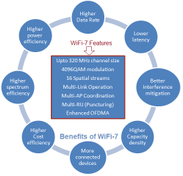
Unicast vs Multicast vs Broadcast: Key Differences Explained
Understand the differences between unicast, multicast, and broadcast transmissions in networking, including their address types, operation, and applications.
Showing 20 posts (Page 6 of 6)
Advertisement

Understand the differences between unicast, multicast, and broadcast transmissions in networking, including their address types, operation, and applications.

Learn the differences between URI, URL, and URN. A URI identifies a resource, a URL locates it, and a URN names it. Understand their roles in networking.

Compare UTP (Unshielded Twisted Pair) and STP (Shielded Twisted Pair) cables. Understand differences in shielding, cost, flexibility, and interference resistance.

Explore the pros and cons of V2X communication, including enhanced safety, efficiency, and potential drawbacks like hacking vulnerabilities and privacy concerns.

Learn the key differences between virtual and physical MAC addresses, including their structure, purpose, and usage in networking.

Explore the pros and cons of Virtual Local Area Networks (VLANs), covering benefits like enhanced security and drawbacks like implementation complexity.
Explore the pros and cons of Voice over Internet Protocol (VoIP), including cost savings, ease of use, sound quality, and security risks.

Explore the differences between VRRP (Virtual Router Redundancy Protocol) and VRF (Virtual Routing Forwarding), their functionalities, and how they work in networking.

Explore the differences between VTP (VLAN Trunking Protocol) and DTP (Dynamic Trunking Protocol) in networking. Understand their functions, modes, features, and advantages.

Explore the advantages and disadvantages of Wavelength Division Multiplexing (WDM), an optical multiplexing technique, in terms of bandwidth, security, and cost.

Explore the pros and cons of Wi-Fi 7 (IEEE 802.11be), including its high speeds, reduced latency, increased complexity, and power consumption.

Explore the distinctions between WiDi and WiFi, understanding their purposes, functionalities, and applications in wireless communication and display technology.

Ace your WiFi 6 interview! Explore frequently asked questions and detailed answers covering key concepts, advantages, and technologies of 802.11ax.

An overview of WiFi 8 (IEEE 802.11bn), the next generation of wireless networking, focusing on planned features like mmWave, multi-link operation, and increased reliability.

Explore WiFi extender vendors and manufacturers, including TP-Link, Netgear, Linksys, and D-Link. Learn about WiFi extender features and models.

Understand the WLAN reassociation request and response frames used when mobile stations move between access points or return to a network.

Explore the X.25 protocol, covering its benefits such as reliability and faster response times, as well as its drawbacks, including low data rates and overhead.

Explore the X.25 protocol stack, including the physical (X.21), frame (LAPB), and packet (PLP) layers. Learn about frame structure and how these layers ensure robust network communication.
Advertisement